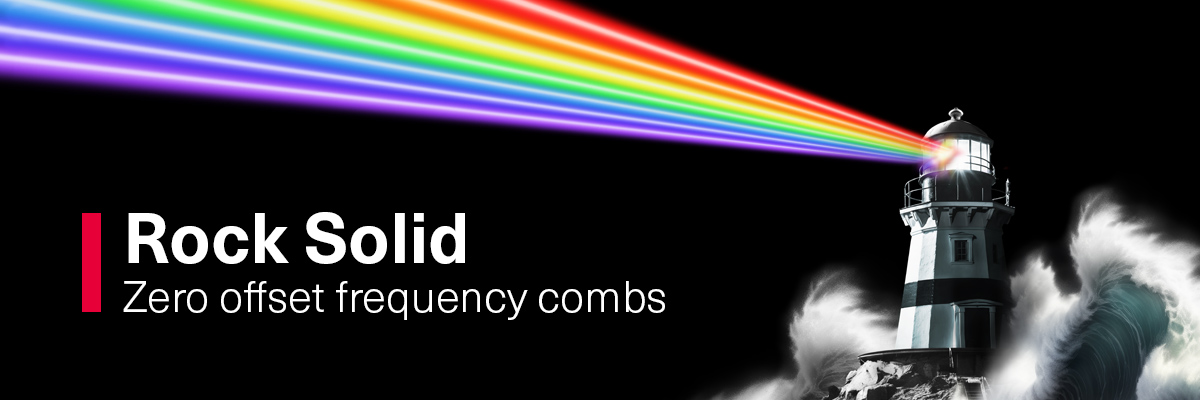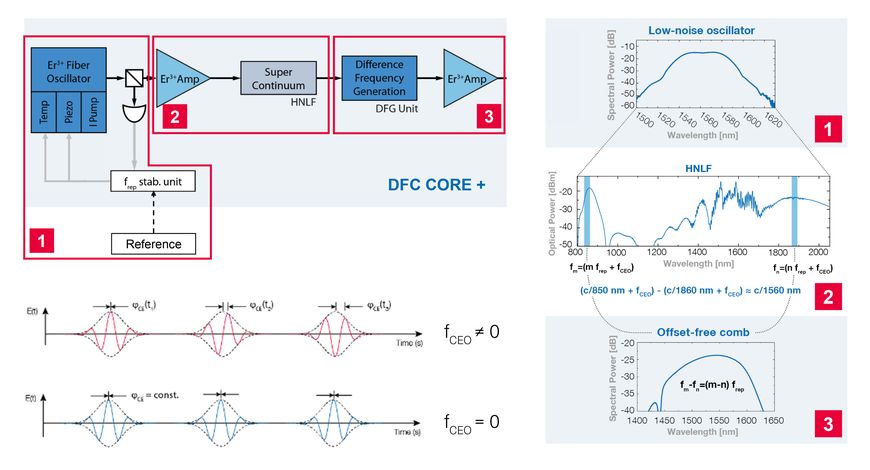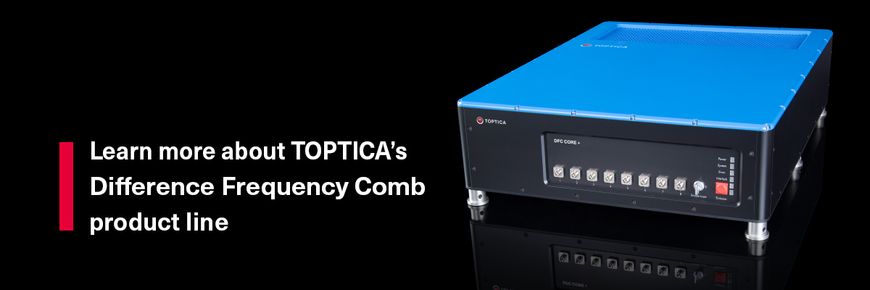私たちは、周波数コムはあらゆる状況においても安定し信頼できるものであるべきだと考えています。
周波数コムは、堅牢で信頼性の高い実験のバックボーンです。この思いが、私たちの周波数コム製品開発の指針となっています。それは、実際の研究にもっと集中し、システムのメンテナンスに費やす時間を減らしたいというお客様との共通のビジョンです。
CERO テクノロジー – zero fCEO
当社が受賞したCEROテクノロジーは、堅牢性と信頼性を兼ね備え、最高の安定性を誇る本質的にfCEOが安定した周波数コム設計を可能にします。TOPTICAの差周波数コム(DFC)のオフセット周波数fCEOは、各光パルスの差周波数発生(DFG)プロセスを利用することにより、受動的にゼロに固定されます。この結果、コム方程式はfn = fCEO + n ・ frepとなり、実験に複数のメリットをもたらします:
光学リファレンスへの完璧なロック

DFGプロセスを通してfCEOをゼロに固定することで、周波数起点で極めて低いノイズを達成し、fCEOとfrepは完全に切り離されます。
これは、コムが狭線幅レーザーのような光レファレンスに安定化されている場合に特に最適です。コムの周波数は0 Hzでしっかりとロックされ、さらに光リファレンスによって高い光周波数(100数THz)でロックされます。CEROテクノロジーは、fCEOの高周波ノイズ成分もキャンセルするため、従来のf-to-2f コムのアプローチよりも明らかに有利となり、すべてのくしの歯は、光リファレンスからの位相ノイズを完全に継承されます。
コムの起点を0 Hzに固定することで、コムの方程式が単純化され、レーザーの絶対周波数を極めて正確に決定することができます:fLaser = fCEO + n・frep ± fBeat
超低ノイズ & 狭線幅

CEROテクノロジーは、オフセット周波数fCEOを安定させるために、受動的な全光位相ロックを使用しています。これにより、従来のf-2f-コムに比べ、当社のコムシステムは電子的なロック・ループを1つ減らすことができます。従って、TOPTICAの周波数コムでは、fCEOは電子ノイズを含まず(高周波でも含まず)、その結果、これまでにない低いキャリアエンベロップ位相(CEP)ノイズと狭いフリーランニング線幅を実現しています。これらの特性により、TOPTICAのDFC CORE +は、線幅と位相ノイズに対して厳しい要求を持つアプリケーションを可能にします。
100倍高速なノイズ除去

受動的な全光ロックを利用することで、DFC CORE +のfCEO有効ロッキング帯域幅は200MHzと高くなります。これにより、電子的なfCEO安定化の帯域幅によって制限される従来のf-2f-combに比べ、100倍の速さで摂動やノイズを抑制します。 これにより、TOPTICAの差周波コムは外部からの影響に対してより堅牢になります。
さらに、CEROテクノロジーは、複雑さを軽減した(ロッキングループが1つ少ない)コムシステムを可能にしました。
CEROテクノロジーとは?
オフセットフリー差周波コム(DFC)の動作原理は、低ノイズエルビウムファイバーモードロック共振器の出力による広帯域なスーパーコンティニュームの発生と、非線形結晶によるオクターブスパンのスペクトルの低周波部と高周波部間で生み出す光学差周波発生により成り立っています。最も重要な特徴は、卓越した安定性、シンプルかつ高い信頼性、全受動型周波数オフセットの安定化です。コムは、 そのオリジナルスペクトルの2つの部分の共通モードの抑制によって、オフセット位相及びオフセット周波数の変動から完全にフリーとなります。加えて、DFCのキャリアエンヴェロープオフセット周波数fCEOは、常にゼロに固定されます。
- Er3+-ファイバー共振器と非線形ファイバーによる広帯域スーパーコンティニュームの生成
- 非線形結晶内のスーパーコンティニュームの低周波と高周波スペクトル部間を用いた差周波生成
- 両スペクトル部は同一の fCEOを持ち相互にキャンセル
- 最終的にコムはキャリアエンベロープ位相を安定化し、fCEO をゼロに固定
- トプティカ社特許技術を採用 (DE102004022037)
完全受動型光学系による fCEO の安定化は、一般的なf-2f干渉計によるアプローチ方法に対して、明確な利点を持ちます。これは、周波数計測分野 (Krauss et al., Opt. Lett, 36, 540 (2011))の数々の有名な研究者によって報告されています。受動安定化の最大の利点は、電気的なノイズによって制限されないことです。加えて、キャリアエンベロープのビート調整や複雑なドリフト補正の必要が無く、キャリアエンヴェロープオフセット ロッキング用のエレクトロニクスがないことにより、複雑な制御エレクトロニクスの必要性を著しく軽減できます。唯一の調整パラメーターは、DFCの繰り返し周波数です。最適な高周波(RF)リファレンスに、簡単に安定化できます。
- DFG in the literature
TOPTICAs frequency comb DFC shows quadratic scaling of the phase noise with frequency. This textbook like behavior has been shown to a remarkable degree. The DFC behaves like an elastic tape with a true fixpoint at zero. An ideal system to be combined with an optical reference. Characterization of a DFG comb showing quadratic scaling of the phase noise with frequency, T. Puppe et al., Optics Letters Vol. 41, Issue 8 (2016)
“The DFG comb possesses a vanishing carrier envelope offset frequency that permits the construction of a simple and thus potentially more stable optical clockwork.“ Zimmermann, Gohle, Holzwarth, Udem and Hänsch, Opt. Lett., 29, 310 (2004)
“This all passive approach provides extremely reliable and rigid locking of fCEO on both short and long time scales”, Krauss, Fehrenbacher, Brida, Riek, Sell, Huber, and Leitenstorfer, Opt. Lett., 36, 540 (2011)
“… in this nonlinear process the phases of the two pulses add up with different signs, leading to CEP cancellation and resulting in passive, all-optical phase stabilization.”Manzoni, Cerullo, and De Silvestri, Opt. Lett., 29, 2668 (2004)
“The unique feature … is that fCEO of the DF is zero without any servo-loop feedback system; i.e., the waveform is self-stabilized in the resultant pulse train.” “The generated phase-stable pulses may - after preamplification - be suitable for seeding high-gain Ti:sapphire amplifiers and (or) the oscillator itself.”Fuji, Apolonski and Krausz, Opt. Lett., 29, 632 (2004)



